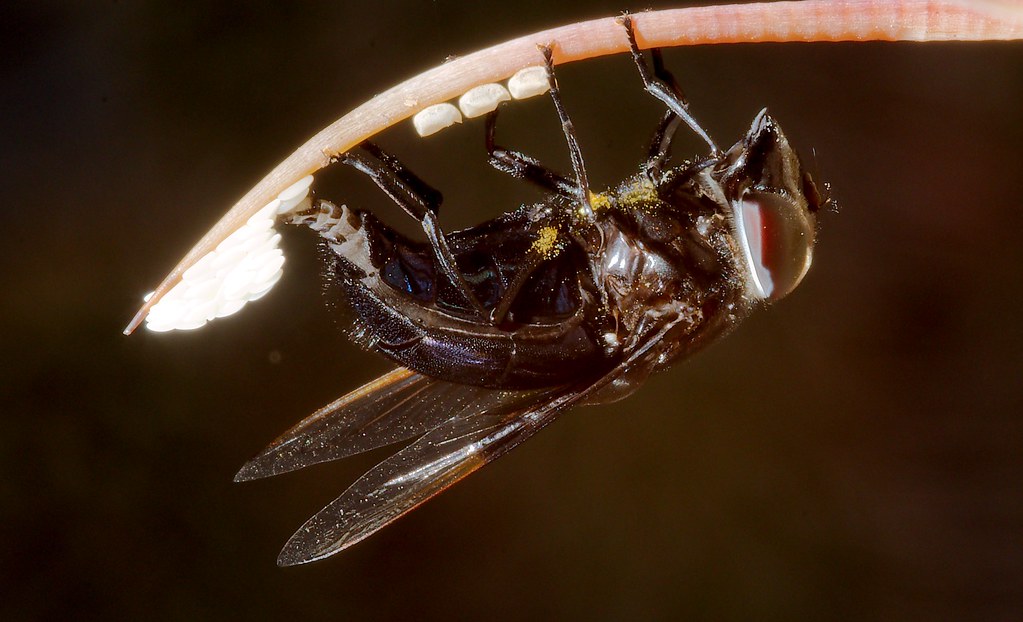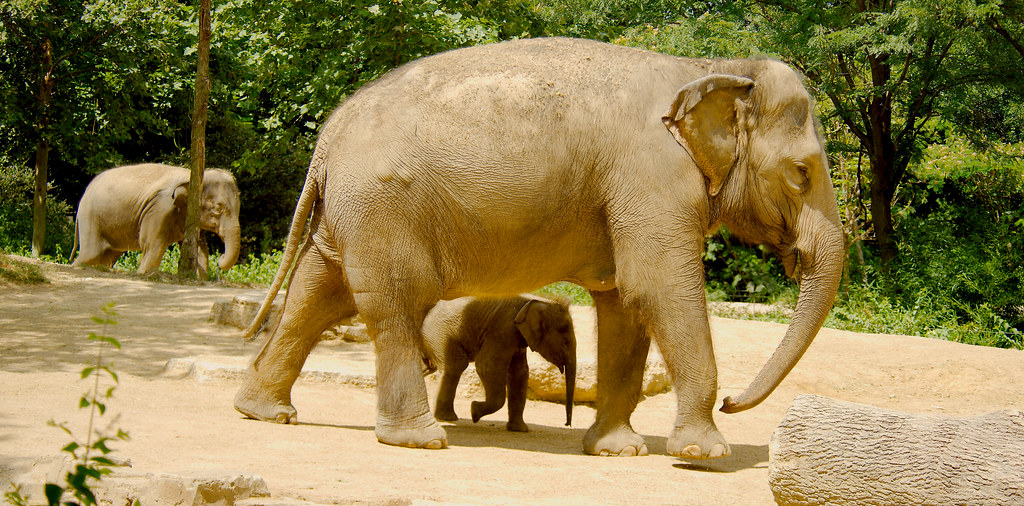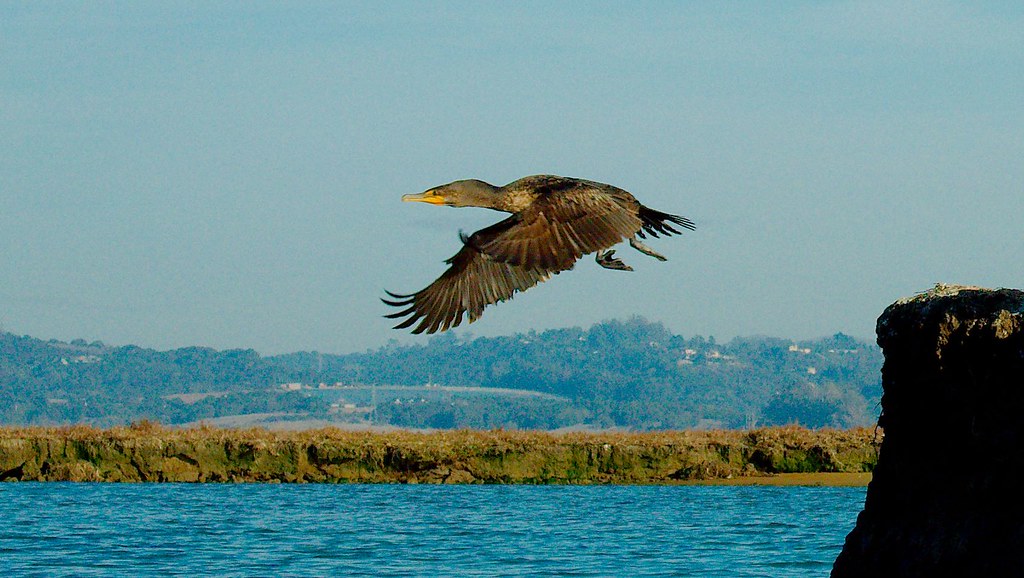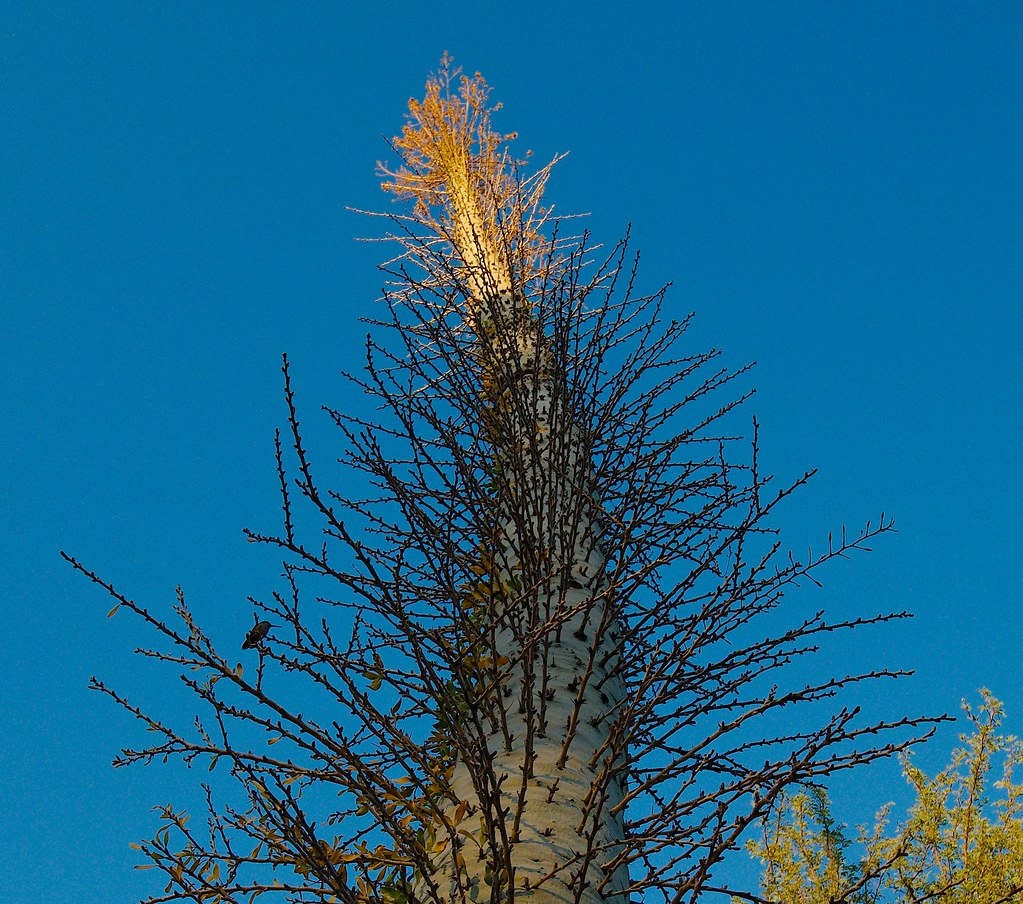
I was very disapointed when I realized that the Boojum Tree was named from “The Hunting of the Snark” instead of the other way around.
Category Archives: Truth
Bee laying eggs
When I was walking in the desert (the botanical garden, to be precise), I noticed a black bee hovering near me. When I was last in Arizona, I had seen similar behavior when a male was attempting to attract the attention of a female. This time, though, there was only one. Since it seemed likely to hang around for a while, I started setting up my lights. As I did so it landed on the underside of a spine and I thought I might get a chance to get some nice close ups. As I worked, I noticed that it was laying eggs. Lots of eggs.
It clung there and laid eggs for about ten minutes, then flew off. This shot was right as the last eggs was being laid. The things you can see here are amazing.
* Fresh eggs are whiter than white. You can see older eggs of other insects further up the spine that are darker.
* These bees lay a lot of eggs. Far more than I had thought they would.
* You can see the pollen on the legs of the bee. Apparently laying eggs just something you do between meals.
* Bees have hairy eyes. I’ve noticed this before, but it still seems weird to me.
After this, I started looking under the spines of other cacti and there are tons of eggs there. I guess it makes sense since insects lay eggs under leaves in forests, and these are just desert leaves. Still, it’s pretty neat to watch.
Tuatara (Sphenodon punctatus)
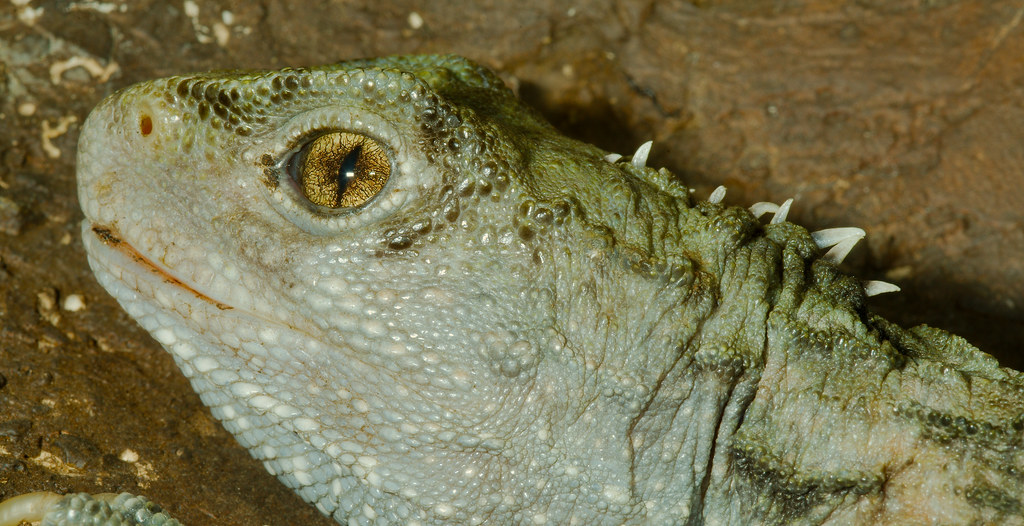
Many years ago, I was reading about evolution and extinction as I brushed my teeth (like ya do) and came across this little fact:
“Very little is known about the intervening history of these enduring creatures. As a matter of fact, there are no known fossils from any part of the Tertiary period – from 2 million to 70 million years ago. In modern times, their world shrank gradually to the confines of the New Zealand archipelago and finally to some 20 remote islets off the coast of New Zealand’s two main islands. Over that long time span, tuataras acquired odd physical attributes, including a third eye that remains in vestigial form at the top of the head.”
I stopped brushing and read that part again. Let me call it out for you in case you missed it:
” … including a third eye that remains in vestigial form at the top of the head … “
That’s right. Somehow, none of the numerous dinosaur books I had read as a kid bothered to mention that there were creatures out there with three eyes and that one was still with us. I mean sure, it’s vestigial. You can only see it in the babies as it quickly gets blocked by scales as they grow up. Still, three eyes! How cool is that?
Thus began my quest to see a tuatara.
I searched for a zoo that had them, and they’re pretty rare. They’re hard to breed and require a different sort of environment than the average reptile, so most zoos didn’t bother. However, the Saint Louis Zoo had one and I eventually managed a trip there. They have a huge reptile area, so if you like herps, it’s the place to go. I battled the crowd, did a quick walk through and eventually found it.
A large, somewhat isolated enclosure with two signs. One said “Tuatara – New Zealand”. The other said “Off Exhibit”.
This happens more often than you’d think. The particularly rare animals, the ones that weird people like me make a special trip to see, are often the least understood. This means they have health issues more often than the rest and they’re just not available to see as often. It’s sad, but then much of the process of trying to see vanishing animals is sad.
The next trip was luckier. I fought the throng, made my way there and, finally, I got to see the tuatara. It was hiding in the enclosure. It took me a bit, but I eventually found it … fast asleep. Not only did I not get to see the third eye (which I didn’t really expect to), but I didn’t get to see any eyes at all.
Disappointed, I took photos in the rest of the reptile area and wandered outside. I was taking photos of an alligator when I saw a zookeeper standing near me. I asked if the tuatara ever woke up, which started a conversation, as it’s apparently also rare for a non-zookeeper to be interested in the rare animals. We arranged a feeding time and I went back to set up.
About half an hour later, I saw some crickets get tossed in and the tuatara woke up. One cricket fell into her burrow, so she ate it (most non-photogenically, I’m sorry to say). I didn’t get many good shots, as she never really got out, but I did get this one that I like. It’s only of one of her eyes and it’s not the special one.
But I think it’s a good eye nonetheless.
Things You Should Consider Before Reading Zoo Articles
I like zoos, but then you probably know that. What you probably don’t know is that in addition to visiting them, I read about them … a lot. Most people don’t. That’s fine, everyone’s interests don’t always have to align. However, when popular sites spread half truths and lies, I think it’s important to call them out.
On July 29th, the Huffington Post, published 11 Things You Should Know Before Planning Your Next Trip To The Zoo. The thesis of the article is that if you care about animals, you should put your money into conservation work instead of in zoos. This is a common view. However, as journalism becomes increasingly emotionally manipulative, I am concerned that the message “don’t give money to zoos, give money directly to conservation groups” is becoming “don’t give money to zoos”, and I have a big problem with that.
So let’s talk about elephants. Specifically, lets talk about the little elephant in the photo above.
The article faults the Association of Zoos and Aquariums (AZA) for hiding the fact that elephants in zoos live shorter lives and have more health problems than those in the wild. It talks about artificial enclosures, animals being moved from zoo to zoo, and that, in some cases, we just don’t know enough to care for the animals. This are all true. However, despite the use of hedge words like “some zoos” and “many zoos”, the overall tone of the article comes down like eleven slams of a hammer striking home the message “zoos are awful”.
Such articles are easy to write now that the Internet puts gigabytes of data at your fingertips. All one needs to to create a list of horrifying facts is run a couple of Google searches and pick the stories that support your view. If you read the actual articles linked to from the Huffington Post piece, you might see a rather different story.
Elephants aren’t doing well in zoos. That’s true. Even the best zoos tend not to have the space that an elephant really needs to be healthy. In fact, many zoos are in the process of moving their elephants to facilities that are better equipped to take care of them. This is not, however, an immediate process. Creating an elephant sanctuary isn’t cheap. Then, once it’s built, it must be funded. Elephants must be fed. New elephants must be moved there. Medical experts must be employed to keep them healthy and, with luck, work towards building a genetically stable population. Also, if the sanctuary is located somewhere that elephant poachers are an issue, you have to consider money for guards and law enforcement.
Who would support this endeavor? Stop for a moment and think of your friends. Now think only of those that can afford to just give away some cash. Now think of what they could do with that money.
- Invest in the stock market to get a good return on their cash
- Support a kickstarter to get a cool toy
- Pay for their kids to go to college
- Buy a new car…
With everything vying for our money, we’re really lucky, actually, that there are people willing to fund these projects.
Ponder why that may be. Maybe, just maybe, it’s because they’ve seen an elephant. Maybe, as children, they stared up at a quiet monster looming over them. Maybe, as parents, they looked down at their children watching trunks twist and twirl like nothing they’d seen before. Maybe they cherish such experiences and wish to ensure that that feeling of respect and awe for something greater than yourself is not lost to future generations.
If you never got to see an elephant in a zoo, how likely do you think it would be to have that experience?
That is what zoos constantly face. They put animals in captivity to keep them safe from those that want to kill them or take over their homes. Once in captivity, they must protect the animals from the cruelty and torment of unthinking zoo guests. They must create an environment in which the animals are comfortable enough to live and breed so populations can be maintained. As few zoos are large enough to sustain stable populations within themselves, so they must also move animals from zoo to zoo. They’re also rescuing animals from the brink of destruction and giving them a place to live while hoping that, along the way, they can learn enough to keep them alive.
All of this must be done while keeping the experience for the people at the zoo “fun enough” for them to keep coming back, thereby providing enough money for the zoo to survive.
I have never met a zookeeper (and I’ve met more than my share) who wouldn’t prefer that their charges be able to live their lives more naturally. I’ve never met one who would say “don’t give money to protect the animals in the wild”. However, I’ve also never met one who would say “keep your money, we’re good”.
The article is right. It would be great if zoos could be less flash and more direct conservation work. The people who work at the zoos feel the same way. They don’t want to be running a daycare for unthinking parents who let their children run as wild as the animals cannot. However, among the many things the article leaves out are:
- Where some animals live, there is no way to prevent people from killing, eating, or selling them. Zoos give these animals a safe place to live while governments address the poverty, graft and corruption that prevents successful conservation.
- There are many things we still don’t know about animals. Zoos provide a way for us to learn about nutrition, psychological needs and environmental dependencies that we simply can’t learn in the wild.
- Scientists in zoos are able to conduct experiments. In the wild some experiments could result in incalculable loss. Though painful, in captivity, such losses can provide strong evidence for why certain practices should never again be attempted.
- Zoos provide a type of education that cannot be given in schools, via the Internet or on TV. Seeing, hearing, smelling and, in some cases, touching and animal makes it real in a way that a picture, no matter how good it is, can do.
And that, really, is the point that the article missed. Zoos are a source of inspiration. Were it not for zoos, that little elephant in the picture above would not exist. Without that elephant, some child ten years from now, may never experience that lightning bolt of awe that only a huge animal can create. Without that experience, that child, as an adult, may never value the lives of those animals they’ve known only as videos on their phone.
The article states “If you want to see wild animals, you should seek a place where you can view animals who are not caged.”. This is true. However, were that the only option, a family of four would have to fly to Africa to see an elephant for the bargain price of $10,000.
Or, who knows, maybe they’d choose to spend only $2,000 and go to Disney World instead.
Wonder what they’d pick.
Northern Elephant Seal (Mirounga angustirostris)
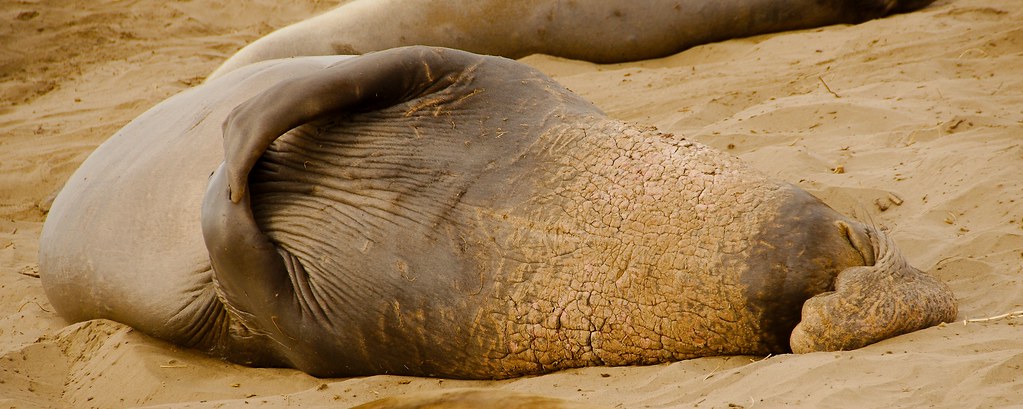
Did you know that elephant seals crawl up on land to rest and then hatch out of their skin like butterflies (but they don’t fly).
Did you know that their nose works like a rebreather?
Did you know that they have sinuses in their abdomens?
Did you know that all of these are actually true?
Elephant seals are neat.
Double-crested Cormorant (Phalacrocorax auritus)
A (somewhat) serious post.
Cormorants are cool because they’re basically really crappy ducks. Ducks have oil in their feathers to help waterproof them for their aquatic life style. (The book Ducks Don’t Get Wet is a great resource for more information, if you’re less than this many: ✋.) One can imagine a time in history when little dinosaurs were floating in the water thinking “this is way too cold, let’s develop oils!” and, millions of years later, we get ducks. Cormorants are just starting out. Who knows, maybe they’ll figure out the oil trick and stop having to spend so much time drying themselves out. Maybe, though, they’ll do something else. They could develop a rubber-like feather (like the kiwi did). They could develop hydrophobic feathers (like lily-pads). They could go even weirder and develop some symbiotic relationship with an algae or something that needs the water more than they do, which absorbs it into their developing young and, when mature, drops off the bird at night, leaving it dry and ready for the next day.
Sadly, the only three ways to find out are:
1) Develop a time machine and travel forward to find out what happens.
2) Develop a stasis machine and be stuck in mid thumb-twiddle for several million years.
3) Hope someone else invents a time machine, thinks that cormorants are just as cool as you do, and comes back in time to tell you all about it. I’m hoping for a visitor at ten this morning.
Monarch Butterfly (Danaus plexippus)
A serious post this time.
Monarch butterflies have a multi-generational migratory cycle. It takes up to four generations for them to flutter between Canada and Mexico every season. As one generation dies, the next one is born hatched. However, monarch caterpillars only eat milkweed. If there’s none available at the stopping place, an entire line of butterflies will die out. As a single species, the monarch illustrates both the complexity and fragility of life. Sadly, we are on the cusp of losing them forever.
In the Winter, monarchs form clusters (or roosts) on branches. This photo is from California, which represents a different set of monarchs. The photographs from Mexico (the primary migrating population) are stunning. I hope to get there some day. The University of Minnesota has a good overview of what happens.
Today, though we’ve answered the question of “Where do the monarchs go?”, we still haven’t figured out how best to protect them. That’s where Monarch Watch comes in. Through a capture and release program, you (as a civilian scientist) can add data to the conservation efforts. By creating monarch waystations, you can help them along their long journey.
When I first went monarch tagging, and I caught (gently) that first butterfly, it nothing like what I had expected. When you take a monarch from the net, you suddenly know, at level deeper than knowledge, how fragile nature can be. When you hold its wings to tag it, you suddenly realize how strong nature can be too. If you have never had that experience, you’re missing out. You owe it to yourself, and future generations, to get involved with the monarch project, at least once.
Bring a friend.
